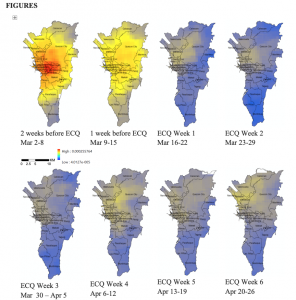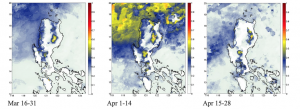
(May 1)—The draconic move to quarantine Metro Manila is causing its residents much inconvenience and anxiety. At the same time, however, they are benefitting from cleaner air brought by the controlled mobility as a consequence of the enhanced community quarantine (ECQ).
Experts from the College of Science and College of Engineering of the University of the Philippines Diliman combined ground-, satellite- and modeling-based approaches to visualize the extent of changes in air quality before the ECQ and while on lockdown.
Prof. Roseanne V. Ramos of the Department of Geodetic Engineering mapped the weekly average NO2 from emissions of cars, trucks, buses, power plants and off-road equipment.
NO2 is a criteria pollutant that “primarily gets in the air from the burning of fuel.”
Elevated levels of NO2 were observed weeks before the ECQ in the northern and central cities of Metro Manila. These levels were seen to decrease in the first two up to the sixth week of quarantine. This observation was confirmed by continuous data from www.airtoday.ph stations at EDSA Muñoz and the Lung Center of the Philippines in Quezon City.

Airtoday.ph measures the pollution index through stations in strategic sites in the metro and is a joint effort of UP Diliman, the Rotary Club of Makati and Lung Center of the Philippines.
On the sixth week since the Luzon-wide ECQ, the NCR reported improved air quality but some provinces outside the capital recorded otherwise.
Plotting the aerosol optical thickness of NO2 using Himawari-1 satellite data products, Prof. Gerry Bagtasa, PhD of the Institute of Environmental Science and Meteorology (IESM) confirmed that the drop in NCR pollution levels in the second week of March is due to the ECQ.
However, parts of Pampanga, Tarlac, and Cagayan Valley provinces actually experienced higher pollution levels due to open burning. He also pointed to the existence of transboundary pollution from the Indochina region in the first half of April since the northern seas (Luzon Strait and north of West Philippine Sea) were evidently polluted, but this did not affect the NCR. The first half of April also marked higher aerosol levels over Rizal and Bulacan provinces but there is still a need to confirm if these are due to burning or other human-related activities.
“Car emission is a big contributor, but not the only contributor to NCR pollution,” Bagtasa said. The second half of April (ECQ Weeks 4, 5 and 6) registered an overall lower pollution in most of Luzon, but an increase in NCR and south of NCR. The slightly higher pollution in NCR maybe due to dust and contamination from open burning in some parts of Central Luzon, brought to NCR by winds from north.

“If we wish to maintain good air quality as the ‘new normal,’ we have to make conscious choices in our pre-ECQ activities,” said IESM Prof. Mylene G. Cayetano, PhD. She emphasized that the people surely felt how clean air surroundings look like after the lockdown, but this is far from what we can expect after the ECQ is lifted. “As we slowly enter the ‘new normal’ activities, the air pollution will go back to moderate to unhealthy levels,” Cayetano said.
Cayetano shared a few tips to improve air quality after the ECQ. These include: avoiding unnecessary idling of vehicles, burning solid wastes in open spaces and smoking in public places; maintaining a road-worthy vehicle through regular maintenance; checking Airtoday.ph before heading out at http://airtoday.ph/www2/airtoday-app/airtoday-map/; and informing people about the benefits of clean air.
To achieve clean air for all, she recommends to strengthen the long-term solutions for inclusive mobility, mass transport systems, green cities, urban planning, road space to non-motorized transport systems, fuel economy and clean energy, and make them happen fast. She also proposes transparency in the emission testing system, proper and rightful apprehension of emission testing violators, and set-up more motor vehicle inspection systems, among others.
“I am with hospital zones to be declared as green or low-emission zones, for the benefit of the sick people present in the area,” she said.
